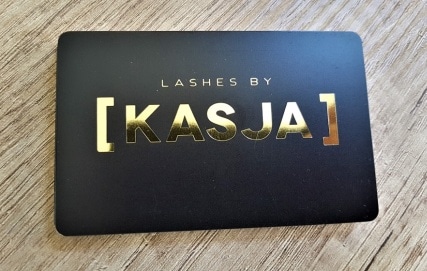Laminated plastic cards= Full color plastic card + Gloss or Matt lamination.
Matt lamination gives your finished printing a soft ‘satin’ finish that is really smooth to the touch. Matt lamination is great for Plastic cards to give a feel of quality to the print.
The matt lamination process we use, applies an extremely thin coating to the card, which provides:
• A soft and silky satin sheen high quality finish resulting in a more sophisticated card.
• Water resistance and durability resulting in a longer life for the card.
How are laminated cards produced,
Usually, the cards are first printed, (multiple cards on a large sheet), and then fed through the laminating unit which feeds a very thin sheet of laminate top & bottom, (or one side only) trapping the card in between. Heat is applied which seals the laminate sandwich.
Why laminated,
As an example, let’s say you have a 2 sided plastic card that needs producing. Let’s also say you decide, on the card reverse, to have a solid color completely covering the card. We will take your artwork and ‘plan’ it into blocks of 4, 6, 8, 10 or even up to 40 cards per block, depending on the quantity ordered.
The card (block) is fed through the printing press and exits into a tray at the end. So, the top of each card will have the bottom of the next card resting on top. If the bottom (reverse) of the next card has been completely covered in ink, it’s perfectly possible for a little of this ink to ‘transfer’ to the card below thereby marking the tops of all cards in the stack.
To overcome the wet ink problem, the press operator will utilise spray powder, which lightly sprays each card as it comes off the press, which effectively helps the drying process. Unbelieveably, some colour inks take longer to dry than others, certains reds & blues for instance, which means that they can still end up in a slightly wet state.
Another option from protecting the card from ink-offset (transfer of ink) is to ‘seal’ the work with a very light covering of machine varnish. The card however, can be left with a slightly glossy sheen.
The most effective way is for lamination. The cards are produced normally and given extra time to dry before each card (block) is sealed in the laminate.
This process totally protects the card from any ink-offset but also enhances the card. If you can get your local printer to show you a solid color printed on a card with, and without lamination, then you will immediately see the difference and realize why so many people are switching to this type of card, even though extra costs are involved. In fact, whether you have used a solid block of colour or not, a laminated card will really give your artwork an extra-professional look.

Matt or Gloss laminated plastic cards,
Both have their uses. If you’re advertising a product or service on your card, or merely wish to make your card really stand out then gloss laminated plastic cards will be the preferred choice. Many tradesmen use this type of ‘advertising’ plastic card as do taxi-drivers, cleaning service companies, mobile hairdressers etc. etc. Many D.I.Y stores, supermarkets etc. will allow you to display your card (for a small fee), alongside every other type of service imaginable, on the store notice board. So, if it’s important for your card to stand out from the rest, a full-color, gloss laminated card would be the perfect choice.
Glossy Plastic Card

Matte Plastic Card

Additional cost for matte lamination
1000pcs
+$80
Double side
UV oil
Order
2000pcs
+$100
Double side
UV oil
Order
3000pcs
+$120
Double side
UV oil
Order
Source: ColorMax Printing supplies Matt plastic card using best material at factory cost
Source: ColorMax Printing supplies Matt plastic card using best material at factory cost




Comments
Post a Comment